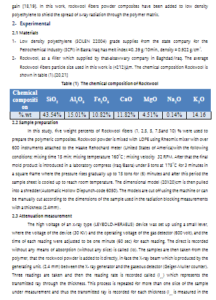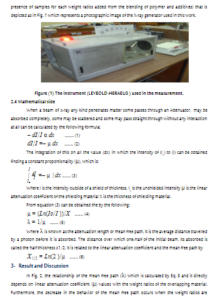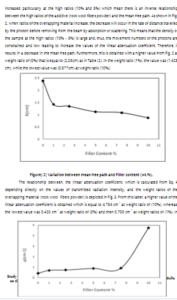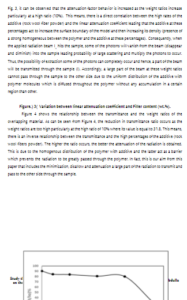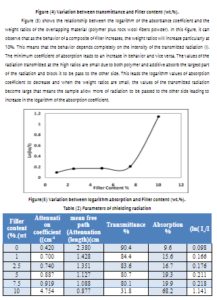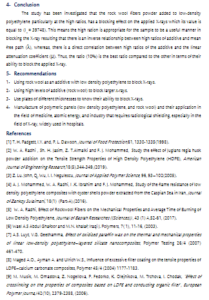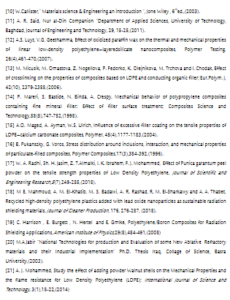Study the effect of addition Rockwool fibers on the Shielding Radiation
for the X-ray of Low Density Polyethylene (LDPE)
Shaymaa H. Jasim
Wisam A. Radhi
Riyadh M. Ramadhan
Raed M.Shaban
Muzahim M.Abdulla
University of Basrah || Iraq
PDF DOI
Tab title
The extinction of X-rays (radiation attenuation) was studied using the low-density samples of polyethylene polymer to which the rockwool fibers powder is added as filled filler. This latter was blended with (weight percent) and with a micro-filler (filler particle) the sizes equal to or less than<212 μm. Furthermore, the free path average and linear attenuation coefficient were calculated. Experimental results showed that the rockwool fibers powder act to reduce the spaces between polymer chains particularly when the weight percent is more than (10%), which implies the capability of the polymer/filler to make, the X-rays applied to the samples; disappear at these rates used in this study. The experimental work was conducted by applying a radiation beam having an energy of 30 kV based on the use of the X-ray unit with two tubes which are; X-ray generating tube and G-M detector with an energy of VG.M =600. The magnitudes of the mean free path are inversely proportional to the weight percent of the compound material whereas the proportionality of these percentages which are particularly the high ones which occur at experimental values of the linear attenuation coefficient. The value of the mean free path of 1.28 cm is the maximum value obtained at a weight percent of 1 %, whereas the minimum value of the mean path was 0.877 cm at a weight percent of 10 %. In addition, the maximum value of the attenuation coefficient obtained is 4.754 cm-1 at a weight percent of 10% and its minimum value at a weight percent of 1% was 0.7 cm-1. The maximum value of transmittance and the minimum value of absorbance were obtained at a weight percent of 10%, are (31.8) and (68.2) respectively. Through the practical results that we obtained that are better suited to high percentages more additive proportions can be used than the percentages used in this research to shielding X-rays more. Keywords: Rockwool fibers, Low Density Polyethylene, Shielding radiation
دراسة تأثير إضافة ألياف الصوف الصخري على الحجب الإشعاعي للأشعة السينية للبولي اثيلين واطىئ الكثافة
شيماء هاشم جاسم
وسام عبد الحسن راضي
رياض منادي رمضان
رائد مسلم شعبان
مزاحم محمد عبد الله
جامعة البصرة || العراق
Tab title
تمت دراسة حجب الأشعة السينية (توهين الأشعة) باستخدام بوليمر بولي اثيلين واطئ الكثافة المضاف اليه مسحوق ألياف الصوف الصخري وعند حجم دقائق مساو او اقل من (<212 μm) ،و تم حساب معدل المسار الحر ومعامل التوهين الخطي ، ومن خلال ملاحظة النتائج العملية تبين ان مسحوق ألياف الصوف الصخري تعمل على تقليل الفراغات بين السلاسل البوليمرية وخاصة عند النسبة الوزنية (10%) مما يعكس امكانية البوليمر مع المضاف( مسحوق ألياف الصوف الصخري) عند هذه النسبة بحجب قسم كبير من الأشعة السينية المسلطة على النماذج . اذ تمت الدراسة العملية بتسليط أشعة مقدارها (30Kv) وباستخدام وحدة الأشعة السينية (X-ray unit) مع انبوبتي توليد الأشعة ومنظومة كاشف عداد كايكر –ميلر(G-M detector ) وبطاقة مقدراها (VG.M =600 volt). ووجد من خلال النتائج العلمية التي تم الحصول عليها من البحث نستنتج بأن قيم معدل المسار الحر تتناسب تناسبا عكسيا مع النسب الوزنية للمادة المتراكبة وان القيم العملية لمعامل التوهين الخطي( μ) تتناسب تناسبا طرديا مع النسب الوزنية للمادة المتراكبة وخاصة عند النسب الوزنية العالية، وتم الحصول على اعلى قيمة لمعدل المسار الحر عند النسب الوزنية (1%) وهي (1.42 cm) بينما كانت اقل قيمة لمعدل المسار الحر هي (0.877 cm) عند النسبة (10%) . كما تم الحصول على اعلى قيمة لمعامل التوهين الخطي وهي (4.754 cm-1) عند النسبة (10%) واقل قيمة كانت عند النسبة (1%) وهي (0.7 cm-1)، كما تم الحصول على اقل قيمة نفاذية واعلى قيمة امتصاصية عند النسبة (10%) وهي (31.8) و (68.2) على التوالي. من خلال النتائج العملية التي حصلنا عليها والتي تكون ملائمة بشكل أفضل مع النسب العالية يمكن استخدام نسب أكبر للمضاف من النسب المستخدمة في هذا البحث لحجب الأشعة السينية بشكل أكبر. الكلمات المفتاحية: الصوف الصخري، البولي اثيلين واطئ الكثافة، الحجب الإشعاعي.
Polyethylene is one of the types of polymers. Divides the polyethylene into two main parts depending on the density, low-density polyethylene (LDPE) and high-density polyethylene (HDPE) [1,2,3]. Low-density Polyethylene is produced by polymerization under high pressure of gas ethylene. LDPE is a partially crystalline solid, density (0.91 – 0.94 g/cm3), proportion of crystallization be (50 – 60 %) and dissolves in the organic solvents above the ( 100 ºC) [4]. Low-density Polyethylene (LDPE) is the non-toxic materials that are used in the industrial applications[5]. LDPE is one of the materials famous commercially on the widely range [6]. The composites of low-density polyethylene are used in different applications, as materials in the cars industry, also as packaging film and window frames [7,8,9].
Fillers are either organic or inorganic, which can be added to polymeric materials to enhance the mechanical, thermal and electrical properties of polymers [10,11]. When fillers are added, the final cost of produced polymers decreases. Polyethylene low density composites are used in automobile industry as well as in a range of daily tools such pipes, packaging film, tubes and window frames [12,13,14,15,16,17].
Polymeric substances which have appropriate neutron attenuation can be generally used as proper alternatives for protecting of γ-radiation and X-rays utilizing several additives such as minerals or heavy metals. Many scientists have improved some polymer composites specifically for their radiation shielding features. Low density polyethylene has mixed with hollow glass spheres. The LDPE has supplied protection of radiation and glass spheres have led to enhance the modulus with using minimal weight
